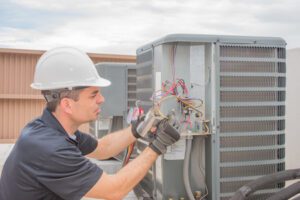What is HVAC? HVAC Explained in Layman’s Terms
HVAC stands for Heating, Ventilation, and Air Conditioning and it’s used to heat and cool your home/business to make sure that you have a comfortable temperature all year long.
HVAC systems filter and clean indoor air to keep you healthy, maintain humidity levels at optimal comfort levels. HVAC systems are installed to prevent fatigue in hot weather while keeping cool during winter months with their ability to regulate body temperature naturally through evaporation or sweating depending on demand- it’s like an environmental remote control.
COMPARE PRICESHow HVAC Works
You can find a radiant system combined with window air conditioning units. However, it is more common for systems that use the same blower to circulate warmed or cooled airflow in your home through internal ducts and out of vents located at various places throughout your house – this includes both central heating AND AC actions.

The HVAC system is the backbone of any building. It not only warms or cools spaces but also improves indoor air quality by removing chemicals and other irritants from inside your home with its ductwork mastery. There are many types of HVAC out there: gas heaters for those who want instant access; forced-air cooling systems that require no maintenance at all (although they can be more expensive). When picking which type suits you best just remember three things – how much space do I have available? What will my budget allow me to install it in front up against?
Ventilation: Ventilation is the process by which air moves in and out, usually through windows or doors. There are two types: natural ventilation (which occurs naturally) as well as forced-air systems with their own set of controls for temperature regulation. Natural vs Artificial – The most important thing when deciding whether you want a ‘natural’ flow from room A into room B instead of vice versa would probably depend on what type of furnishings were being used; if lots of furniture had dense fabrics that required constant brushing then I might opt instead for artificial.
Mechanical Ventilation: Mechanical ventilation is a vital part of keeping your home at the right temperature. It ensures that there are no dirt particles or allergens entering through gaps, cracks in construction along with opening and closing doors which can cause illness when inhaled by those who live inside them. A mechanical system called “the V” moves air into homes before being drawn out again through filters where they’ve removed all types of impurities including dust mites plus more.
Cooling & Heating: Air that’s dirty and humid must be cooled or heated before being sent to your home. For central systems, it goes through a network of ducts while for other types this usually means being directed right into the space without any extra steps taken in between.
What is the Difference between AC and HVAC?

The design and engineering of quality HVAC systems is a subdiscipline within mechanical engineering, based on the principles laid out by thermodynamics (temperature characteristics), fluid mechanics(pressure relief valve), and heat transfer. The added term “refrigeration” often refers specifically to air conditioning whereas others may use it interchangeably with ventilation or ACR-rated breakers.
The three primary functions of heating, ventilation, and air conditioning are interrelated. With a need to deliver thermal comfort in addition to clean indoor air within reasonable distances; HVAC systems can be used for both domestic environments as well commercial ones with their ability not only to deliver but also maintain pressure relationships between spaces through proper room distribution.
COMPARE PRICES


Leave a Reply